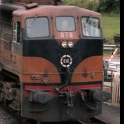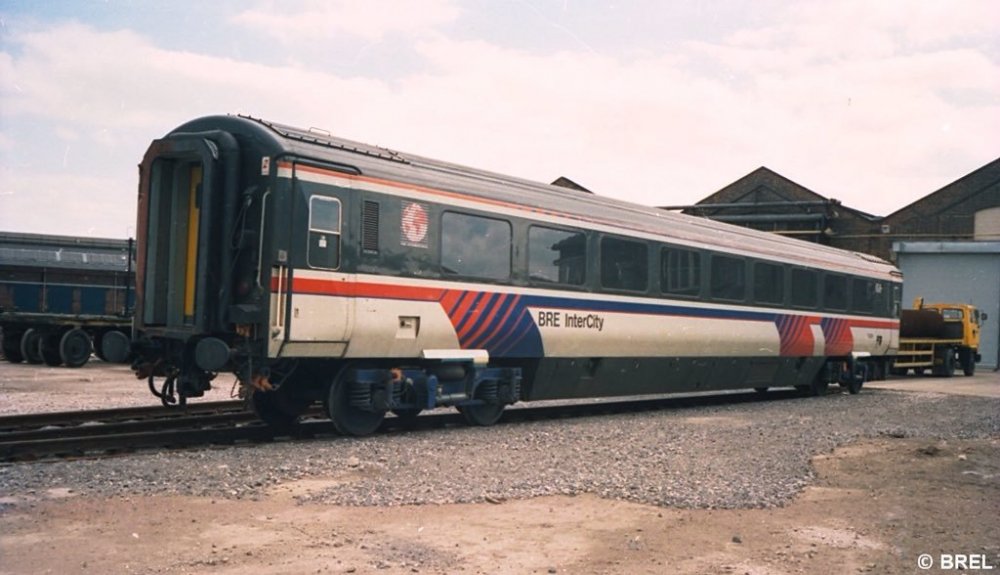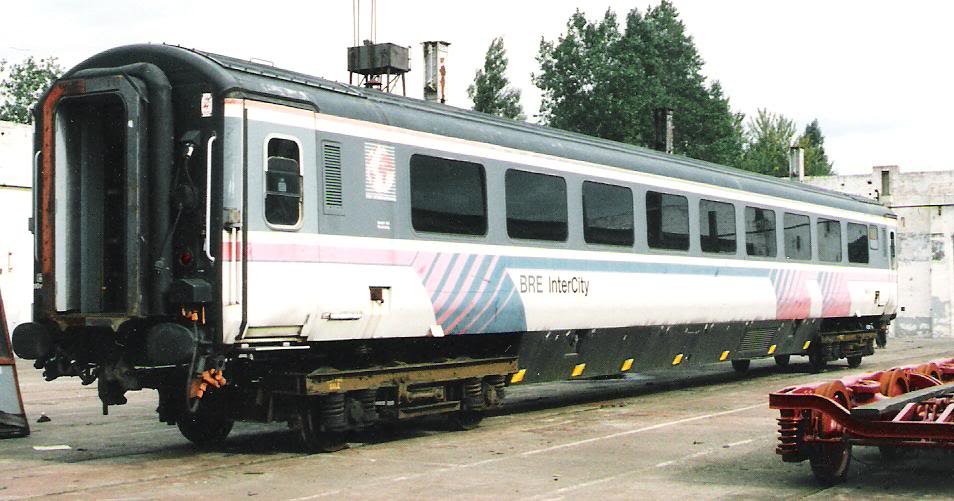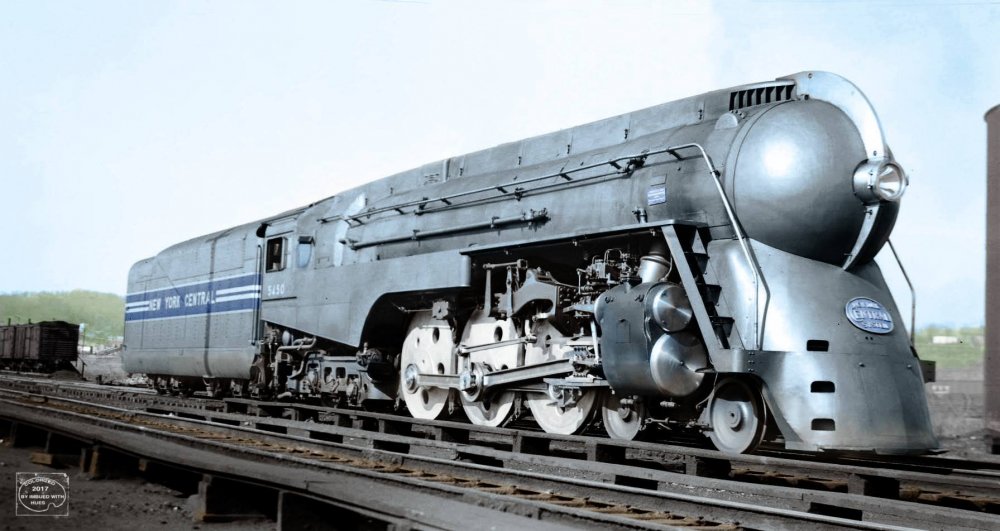-
Posts
420 -
Joined
-
Last visited
Content Type
Profiles
Forums
Events
Gallery
Blogs
Store
Community Map
Everything posted by hexagon789
-

BR blue & grey on Irish rails
hexagon789 replied to dave182's topic in Photos & Videos of the Prototype
I have to say I hadn't realised how bad the colour fading was on that photo, here's one which clearly shows the actual colours: Much clearer how the general scheme is much more similar to IC Sector. As to your question, I'm not aware of any rtr model of these coaches of any sort but there were some conversion kits by someone I think -
Looks like it!
-
@jhb171achill can I ask what that layout is? Nothing short of spectacular in the scenics department.
-
To be fair, even with today's modern much lighter railcar/DMUs, sand is generally only used for emergency braking or in higher brake settings if wheelslide is detected, traction often relies solely on modern wheelspin protection and creep control systems to deliver as much power as possible to the rails without provoking significant slippage (a degree of slippage is permitted, usually about 8%, as maximum grip is actually obtained with a small degree of slip).
-
Perhaps because of the number of driven axles? All very well having an 071 with its 2475hp gross/2250hp net/1833hp at-rail but it's not much use if you can't get that all that power down at the rails. A 201 might fare better with its creep control and microprocessor WSP though Always has been, I remember reading an article in The Journal which mentioned a few instances of such, "A"s and "C"s were very sure-footed by comparison, though even with the original Crossley engines in Notch 9 or 10 an "A" would undoubtedly slip at low speed, assuming the engine didn't shut down first!
-
I think a considerably-sized thread could be very easily filled with details of rolling stock interiors, the variations are so innumerable!
-
Different body profile as well as different windows. A standard Mk3 bodyshell has eight saloon windows, the Internationals had nine, hence the higher seating capacity in both first class and standard class as built - 54 and 76 respectively (against 48 and 72 for Mk3s generally).
-
Albeit not really Mk3
-
I don't think so, quite a niche design. While I believe in Ireland they were refereed to as Mk3A, they are really little like a Mk3. In the UK for instance, Mk3 referred to the HST trailers, the Mk3A were the first batch of loco-hauled Mk3s, Mk3B the second batch. The Cú na Mara set was ex-British Rail Engineering Limited, described as the "International Train" it being intended to demonstrate what BREL could produce to drum up orders from abroad that never materialised. The stock did run on a specific London Euston-Manchester diagram for a period in lieu of a normal Mk3 set, the coaches were permitted to run at 110mph.
-
Well that's all the Mk 2D gone, I thought about it but I think that's the world saying get them another time. The lack of EGV and diner made me hesitate. Still nice to know where to go in the future for any orders
-
That might be it then, trouble is you read so many things in so many places they tend to blur somewhat!
-
I think it says a lot though, that even after some decades, it's still quite a modern looking design. If anything I think the 'wings' enhance the roundel design, it gives more of an air of speed than one could hope to achieve on most of the tube in London and certainly would be achievable on a bus with dense London traffic. Perhaps it's just coincide that the snail makes things seem faster, or did the designers have a cunning plan to quicken people journeys without actually tightening the schedules?
-
You can see the difference in the "orange" too between batches, the latter is more brownish with less yellow in it and looks more "correct" to my eyes. If there were EGVs and diners still kicking about it would be tempted at the keen prices. Excuse me if I remember wrongly, but I seem to recall reading, not on this forum I add, that there would be another batch but I don't think they were to be Supertrain. Personally, I'd love more in Supertrain myself!
-

BR blue & grey on Irish rails
hexagon789 replied to dave182's topic in Photos & Videos of the Prototype
Effectively BR InterCity Sector livery with slight colour variation, picture here of an unconverted one at Inchicore on B4 accommodation bogies: -

BR blue & grey on Irish rails
hexagon789 replied to dave182's topic in Photos & Videos of the Prototype
Yes, but that wasn't blue/grey. Still has the BR data panels as well, giving it a 100mph maximum speed. Does that make it the fastest Mk2 in Ireland? -
1,200hp I think hence the LWT12 coding, designed to enable it to run at 100mph though it was downgraded to 80mph fairly soon after modifications and struggled on gradients so required assistance from much more powerful locos to bank it. I believe two power cars survive.
-
I suppose that would depend on where they took their inspiration from? Just so long as it wasn't the UK Great Western Railway, have you seen their utterly abominable attempt at the streamlining craze? And still no faster nor more frequent in spite of their replacement! The AM800s were supposed to give an improved service of eight to nine daily "rapides" taking 2hrs 30 Ajaccio-Bastia, yet I believe pre-Virus they were still using the previous 4 stoppers each-way 3hrs40-4hrs timetable. The saving grace is more time to enjoy the scenery one could say! It was to match a new set of coaching stock specially built for an improved East Anglian London-Ipswich-Norwich express.
-
Sorry, suddenly realised I forgot to put the photo in! New York Central J-3a 4-6-4 Hudson If I did a top 5 of steam locos, that's going in!
-
Funnily enough the NYC was one of the slower Railroad's of the period. It's MAS (Maximum Authorised Speed) was 80 except for the route of the 20th Century Limited which went up to 85mph. I think that's the only period in US railway history I can get excited about, when a huge profusion of railroads ran a plethora of named trains at decent speeds, with a wide variety of unique and much more stylish than now, locomotives. The NYC Hudsons are among my favourite American locomotives, if ever since steam loco could look futuristic I reckon it would look like that.
-
Sir Nigel himself only accepted Mallard had attained 125 and I believe the dynamometer rolls (which are in the National Railway Museum at York and can be inspected) only record a brief peak of 125.88mph so I think it's very, very tight. As for the Milwaukee Road, their F7s were reputed to require to exceed 100mph just to maintain schedules, at one point on the mainline from Chicago to the Twin Cities, at Rondout there was a famous sign at the interlocking: "SLOW TO 90", and that was in the late-1930s! Sadly the line is like so many in the US a shadow of its former self, and 79mph max. I find it ironic that was is now the fastest line in America, the Northeast Corridor was in US rail's heyday of the 1930s-1950s only 80mph maximum, while lines which then permitted 85, 90, 95 and 100mph are almost all much slower.
-
Probably because it utterly destroyed the track in its wake! They also not only had to resort to using the second pantograph about halfway through the run but at the end of it discovered that the carbon strips hadn't simply worn away it had actually melted from the heat generated by the huge currents being drawn off the overheads!
-
They actually did 331km/h TWICE in March 1955, but with different types of loco from different manufacturers (the other class was the Bo-Bo BB 9000), identical speeds being attained so as to give neither manufacturer "favour" as it were. Technically the second record was only 325km/h but SNCF officially credited both as 331 for the reason I outlined.
-
Thanks for that jhb and the photo, they remind of another continental class aesthetically. I've ridden the Soller railway on Majorca but not the other system out to Sa Pobla and Manacor. The narrow guage system I would like to experience is that of Corsica with its 153km mainline across the hilly interior of the island, though it's a shame the 1940s Renaults have gone now.
-
If I may offer another piece of data which cements the Deltic's place as the top dog of British diesels? Only two years before they were withdrawn, one of the few top ECML expresses which had not become an HST, the Hull Executive was retimed in 1979, departing from King's Cross it's first booked call was Retford, 138 miles, 49 chains up the line in a blistering 91 minutes, a start-to-stop average of 91.3mph! And that was based on only 100mph maximum running, though 55s were capable of plenty more in their twilight years after the traction motors were beefed up accordingly.
-
A nice selection of motive power there, the only class I'm not familiar with is the J15, but then I'm not really au fait with Irish steam in general save the GSR B1a/800 Class.
.png.c363cdf5c3fb7955cd92a55eb6dbbae0.png)





